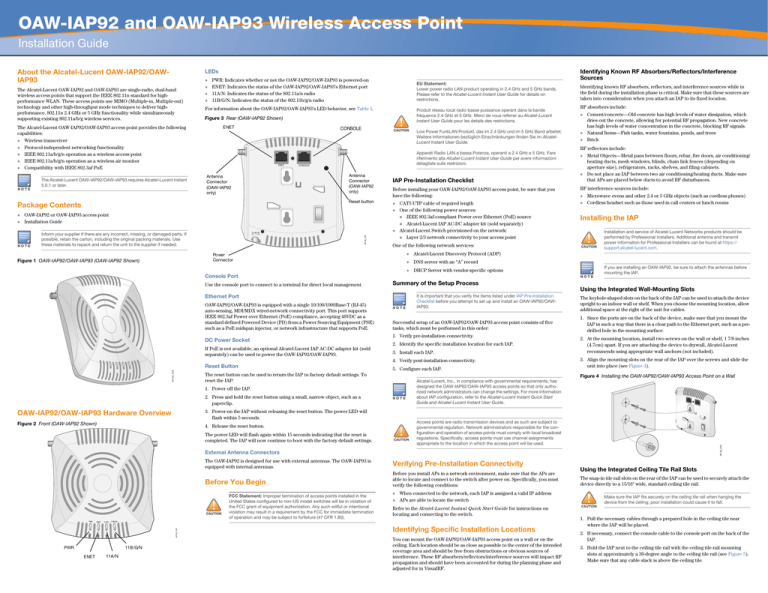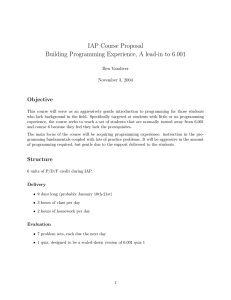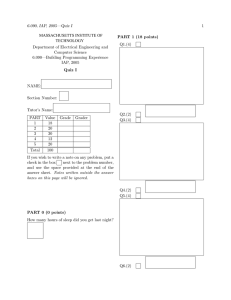
OAW-IAP92 and OAW-IAP93 Wireless Access Point
Installation Guide
About the Alcatel-Lucent OAW-IAP92/OAWIAP93
The Alcatel-Lucent OAW-IAP92 and OAW-IAP93 are single-radio, dual-band
wireless access points that support the IEEE 802.11n standard for highperformance WLAN. These access points use MIMO (Multiple-in, Multiple-out)
technology and other high-throughput mode techniques to deliver highperformance, 802.11n 2.4 GHz or 5 GHz functionality while simultaneously
supporting existing 802.11a/b/g wireless services.
The Alcatel-Lucent OAW-IAP92/OAW-IAP93 access point provides the following
capabilities:
PWR: Indicates whether or not the OAW-IAP92/OAW-IAP93 is powered-on
ENET: Indicates the status of the OAW-IAP92/OAW-IAP93’s Ethernet port
11A/N: Indicates the status of the 802.11a/n radio
11B/G/N: Indicates the status of the 802.11b/g/n radio
For information about the OAW-IAP92/OAW-IAP93’s LED behavior, see Table 1.
ENET
CONSOLE
Low Power FunkLAN Produkt, das im 2.4 GHz und im 5 GHz Band arbeitet.
Weitere Informationen bezlüglich Einschränkungen finden Sie im AlcatelLucent Instant User Guide.
Identifying known RF absorbers, reflectors, and interference sources while in
the field during the installation phase is critical. Make sure that these sources are
taken into consideration when you attach an IAP to its fixed location.
RF absorbers include:
Cement/concrete—Old concrete has high levels of water dissipation, which
dries out the concrete, allowing for potential RF propagation. New concrete
has high levels of water concentration in the concrete, blocking RF signals.
Natural Items—Fish tanks, water fountains, ponds, and trees
Brick
RF reflectors include:
ENET
Apparati Radio LAN a bassa Potenza, operanti a 2.4 GHz e 5 GHz. Fare
riferimento alla Alcatel-Lucent Instant User Guide per avere informazioni
detagliate sulle restrizioni.
CONSOLE
Antenna
Connector
(OAW-IAP92
only)
Antenna
Connector
(OAW-IAP92
only)
Reset button
Package Contents
Produit réseau local radio basse puissance operant dans la bande
fréquence 2.4 GHz et 5 GHz. Merci de vous referrer au Alcatel-Lucent
Instant User Guide pour les details des restrictions.
Figure 3 Rear (OAW-IAP92 Shown)
Wireless transceiver
Protocol-independent networking functionality
IEEE 802.11a/b/g/n operation as a wireless access point
IEEE 802.11a/b/g/n operation as a wireless air monitor
Compatibility with IEEE 802.3af PoE
The Alcatel-Lucent OAW-IAP92/OAW-IAP93 requires Alcatel-Lucent Instant
5.0.1 or later.
EU Statement:
Lower power radio LAN product operating in 2.4 GHz and 5 GHz bands.
Please refer to the Alcatel-Lucent Instant User Guide for details on
restrictions.
IAP Pre-Installation Checklist
Before installing your OAW-IAP92/OAW-IAP93 access point, be sure that you
have the following:
OAW-IAP92 or OAW-IAP93 access point
Installation Guide
Inform your supplier if there are any incorrect, missing, or damaged parts. If
possible, retain the carton, including the original packing materials. Use
these materials to repack and return the unit to the supplier if needed.
12V
1.25A
CAT5 UTP cable of required length
One of the following power sources:
IEEE 802.3af-compliant Power over Ethernet (PoE) source
Alcatel-Lucent IAP AC-DC adapter kit (sold separately)
Alcatel-Lucent Switch provisioned on the network:
Layer 2/3 network connectivity to your access point
One of the following network services:
Power
Connector
Figure 1 OAW-IAP92/OAW-IAP93 (OAW-IAP92 Shown)
Alcatel-Lucent Discovery Protocol (ADP)
DNS server with an “A” record
DHCP Server with vendor-specific options
Console Port
Use the console port to connect to a terminal for direct local management.
DC Power Socket
If PoE is not available, an optional Alcatel-Lucent IAP AC-DC adapter kit (sold
separately) can be used to power the OAW-IAP92/OAW-IAP93.
Successful setup of an OAW-IAP92/OAW-IAP93 access point consists of five
tasks, which must be performed in this order:
1. Verify pre-installation connectivity.
2. Identify the specific installation location for each IAP.
3. Install each IAP.
AP-92_005
5. Configure each IAP.
The reset button can be used to return the IAP to factory default settings. To
reset the IAP:
Figure 2 Front (OAW-IAP92 Shown)
4. Release the reset button.
Microwave ovens and other 2.4 or 5 GHz objects (such as cordless phones)
Cordless headset such as those used in call centers or lunch rooms
Installing the IAP
Installation and service of Alcatel-Lucent Networks products should be
performed by Professional Installers. Additional antenna and transmit
power information for Professional Installers can be found at https://
support.alcatel-lucent.com.
If you are installing an OAW-IAP92, be sure to attach the antennas before
mounting the IAP.
The keyhole-shaped slots on the back of the IAP can be used to attach the device
upright to an indoor wall or shelf. When you choose the mounting location, allow
additional space at the right of the unit for cables.
1. Since the ports are on the back of the device, make sure that you mount the
IAP in such a way that there is a clear path to the Ethernet port, such as a predrilled hole in the mounting surface.
2. At the mounting location, install two screws on the wall or shelf, 1 7/8 inches
(4.7cm) apart. If you are attaching the device to drywall, Alcatel-Lucent
recommends using appropriate wall anchors (not included).
3. Align the mounting slots on the rear of the IAP over the screws and slide the
unit into place (see Figure 4).
Figure 4 Installing the OAW-IAP92/OAW-IAP93 Access Point on a Wall
2. Press and hold the reset button using a small, narrow object, such as a
paperclip.
3. Power-on the IAP without releasing the reset button. The power LED will
flash within 5 seconds.
Alcatel-Lucent, Inc., in compliance with governmental requirements, has
designed the OAW-IAP92/OAW-IAP93 access points so that only authorized network administrators can change the settings. For more information
about IAP configuration, refer to the Alcatel-Lucent Instant Quick Start
Guide and Alcatel-Lucent Instant User Guide.
1. Power off the IAP.
OAW-IAP92/OAW-IAP93 Hardware Overview
RF interference sources include:
Using the Integrated Wall-Mounting Slots
It is important that you verify the items listed under IAP Pre-Installation
Checklist before you attempt to set up and install an OAW-IAP92/OAWIAP93.
4. Verify post-installation connectivity.
Reset Button
Metal Objects—Metal pans between floors, rebar, fire doors, air conditioning/
heating ducts, mesh windows, blinds, chain link fences (depending on
aperture size), refrigerators, racks, shelves, and filing cabinets.
Do not place an IAP between two air conditioning/heating ducts. Make sure
that APs are placed below ducts to avoid RF disturbances.
Summary of the Setup Process
Ethernet Port
OAW-IAP92/OAW-IAP93 is equipped with a single 10/100/1000Base-T (RJ-45)
auto-sensing, MDI/MDX wired-network connectivity port. This port supports
IEEE 802.3af Power over Ethernet (PoE) compliance, accepting 48VDC as a
standard defined Powered Device (PD) from a Power Sourcing Equipment (PSE)
such as a PoE midspan injector, or network infrastructure that supports PoE.
Access points are radio transmission devices and as such are subject to
governmental regulation. Network administrators responsible for the configuration and operation of access points must comply with local broadcast
regulations. Specifically, access points must use channel assignments
appropriate to the location in which the access point will be used.
The power LED will flash again within 15 seconds indicating that the reset is
completed. The IAP will now continue to boot with the factory default settings.
AP-92_003
AP-92_002
Identifying Known RF Absorbers/Reflectors/Interference
Sources
LEDs
External Antenna Connectors
The OAW-IAP92 is designed for use with external antennas. The OAW-IAP93 is
equipped with internal antennas.
Verifying Pre-Installation Connectivity
Before You Begin
Before you install APs in a network environment, make sure that the APs are
able to locate and connect to the switch after power on. Specifically, you must
verify the following conditions:
AP-92_001
FCC Statement: Improper termination of access points installed in the
United States configured to non-US model switches will be in violation of
the FCC grant of equipment authorization. Any such willful or intentional
violation may result in a requirement by the FCC for immediate termination
of operation and may be subject to forfeiture (47 CFR 1.80).
PWR
11B /G/N
ENET
11A/N
When connected to the network, each IAP is assigned a valid IP address
APs are able to locate the switch
Using the Integrated Ceiling Tile Rail Slots
The snap-in tile rail slots on the rear of the IAP can be used to securely attach the
device directly to a 15/16" wide, standard ceiling tile rail.
Make sure the IAP fits securely on the ceiling tile rail when hanging the
device from the ceiling; poor installation could cause it to fall.
Refer to the Alcatel-Lucent Instant Quick Start Guide for instructions on
locating and connecting to the switch.
Identifying Specific Installation Locations
You can mount the OAW-IAP92/OAW-IAP93 access point on a wall or on the
ceiling. Each location should be as close as possible to the center of the intended
coverage area and should be free from obstructions or obvious sources of
interference. These RF absorbers/reflectors/interference sources will impact RF
propagation and should have been accounted for during the planning phase and
adjusted for in VisualRF.
1. Pull the necessary cables through a prepared hole in the ceiling tile near
where the IAP will be placed.
2. If necessary, connect the console cable to the console port on the back of the
IAP.
3. Hold the IAP next to the ceiling tile rail with the ceiling tile rail mounting
slots at approximately a 30-degree angle to the ceiling tile rail (see Figure 5).
Make sure that any cable slack is above the ceiling tile.
Figure 5 Orienting the Ceiling Tile Rail Mounting Slots
Instant Quick Start Guide for further details on verifying post-installation
network connectivity.
China RoHS
Table 1 OAW-IAP92/OAW-IAP93 Series LED Meanings
Color/State
Meaning
PWR
Off
No power to IAP
Green flashing
System initializing
Red steady
System failed to initialize, contact TAC
Green steady
Power on, device ready
Off
No link
Green on
1000 Mbps link
Amber on
10/100 Mbps link
Off
5 GHz radio is disabled
Install cables in accordance with all applicable local and national regulations and
practices.
Amber
5 GHz radio enabled in
WLAN mode
Ethernet Ports
Green
5 GHz radio enabled in
11n mode
Green flashing
5 GHz Air Monitor or RF
Protect mode
AP-92_004
LED
4. Pushing toward the ceiling tile, rotate the IAP clockwise until the device
clicks into place on the ceiling tile rail.
Connecting Required Cables
ENET
(10/100/1000 Mbps)
11A/N
The RJ45 Ethernet port (ENET) supports 10/100/1000Base-T auto-sensing MDI/
MDX connections. Use these ports to connect the IAP to a twisted pair Ethernet
LAN segment or directly to an Alcatel-Lucent Switch. Use a 4- or 8-conductor,
Category 5 UTP cable up to 100 m (325 feet) long.
11B/G/N
The 10/100/1000 Mbps Ethernet port is on the back of the IAP. The port has an RJ45 female connector with the pin-outs shown in the figure below.
Figure 6 Gigabit Ethernet Port Pin-Out
1000Base-T Gigabit
Ethernet Port
RJ-45 Female
Pin-Out
1
2
3
4
5
6
7
8
Signal Name
Function
BI_DA+
BI_DABI_DB+
BI_DC+
BI_DCBI_DBBI_DD+
BI_DD-
Bi-directional pair +A
Bi-directional pair -A
Bi-directional pair +B
Bi-directional pair +C
Bi-directional pair -C
Bi-directional pair -B
Bi-directional pair +D
Bi-directional pair -D
Off
2.4 GHz radio disabled
Amber
2.4 GHz radio enabled in
WLAN mode
Green
2.4 GHz radio enabled in
11n mode
Green flashing
2.4 GHz Air Monitor or
RF Protect mode
Product Specifications
10
OAW-IAP92 and OAW-IAP93
Wireless Access Point
Installation Guide
Contacting Alcatel-Lucent
Table 1
Web Site Support
Safety and Regulatory Compliance
Alcatel-Lucent Networks provides a multi-language document that contains
country-specific restrictions and additional safety and regulatory information for
all Alcatel-Lucent access points. This document can be viewed or downloaded
from the following location: https://service.esd.alcatel-lucent.com.
The device will be electronically labeled and the FCC ID will be displayed via the
switch WebUI under the About menu.
Alcatel-Lucent access points must be installed by a professional installer.
The professional installer is responsible for ensuring that grounding is
available and it meets applicable local and national electrical codes.
Electrical
Serial Console Port
The serial console port (Console) allows you to connect the IAP to a serial
terminal or a laptop for direct local management. This port is an RJ-45 female
connector with the pinouts described in Figure 7. Connect this port directly to a
terminal or terminal server using an Ethernet cable.
Use a modular adapter to convert the RJ-45 (female) connector on the IAP to a
DB-9 (male) connector, and connect the adapter to a laptop using an RS-232
cable. See Figure 8 for connector details of the adapter.
Figure 7 Serial Port Pin-Out
Serial
Console Port
RJ-45 Female
Pin-Out
1
2
3
4
5
6
7
8
Direction
Input
Output
TxD
GND
GND
RxD
For additional specifications on this product, please refer to the data sheet. The
data sheet can be found at www.alcatel-lucent.com.
DB-9 Male
Pin-Out
DB-9
2
5
3
RF Radiation Exposure Statement: This equipment complies with FCC
RF radiation exposure limits. This equipment should be installed and operated with a minimum distance of 7.87 inches (20cm) between the radiator
and your body for 2.4 GHz and 5 GHz operations. This transmitter must not
be co-located or operating in conjunction with any other antenna or transmitter. When operated in the 5.15 to 5.25 GHz frequency range, this device
is restricted to indoor use.
Main Site
http://www.alcatel-lucent.com/enterprise
Support Site
https://service.esd.alcatel-lucent.com/
Table 2
Telephone Support
North America
1-800-995-2696
Latin America
1-877-919-9526
Europe
+33 (0) 38 855 6929
Asia Pacific
+65 6240 8484
Worldwide
1-818-878-4507
Copyright
© 2011 Alcatel-Lucent, Inc. All rights reserved.
Specifications in this manual are subject to change without notice.
Originated in the USA.
EMC Compliance and Warning Statement
IEC 60601-1-2: 2007
EN 60601-1-2: 2007
Any other trademarks appearing in this manual are the property of their respective companies.
Legal Notice
This hardware product is protected by the Alcatel-Lucent Limited Lifetime warranty
Internal
Connections
RJ-45
TxD
3
4
5
GND
RxD
6
Ethernet:
1 x 10/100/1000Base-T auto-sensing Ethernet RJ-45 Interfaces
MDI/MDX
IEEE 802.3 (10Base-T), IEEE 802.3u (100Base-T). IEEE 802.3ab
(1000Base-T)
Power over Ethernet (IEEE 802.3af compliant), 48V DC/350mA (see Figure
6 for pin configuration)
Power:
12 VDC power interface, supports powering through an AC-to-DC power
adapter
If a power adapter other than the one provided by Alcatel-Lucent Networks
is used in the US or Canada, it should be cULus (NRTL) Listed, with an output rated 12 VDC, minimum 1.25A, marked “LPS” or “Class 2,” and suitable for plugging into a standard power receptacle in the US and Canada.
Figure 8 RJ-45 (Female) to DB-9 (Male) Modular Adapter Conversion
RJ-45 Female
Pin-Out
1
2
3
TxD
4
5
GND
6
RxD
7
8
Direction
Input
Output
Alcatel-Lucent products also comply with China environmental
declaration requirements and are labeled with the “EFUP 10” label
shown at the left.
9
8
7
6
5
4
3
2
1
Ground
RxD
TxD
Direction
Input
Output
Power Connection
The OAW-IAP92/OAW-IAP93 has a single 12V DC power jack socket to support
powering through an AC-to-DC power adapter.
If both POE and DC power are available, the IAP uses POE even when
there is not enough POE voltage available to power the IAP.
Verifying Post-Installation Connectivity
The integrated LEDs on the IAP can be used to verify that the IAP is receiving
power and initializing successfully (see Table 1). Refer to the Alcatel-Lucent
Proper Disposal of Alcatel-Lucent Equipment
For the most current information about Global Environmental Compliance and
Alcatel-Lucent products, see our website at www.alcatel-lucent.com.
Waste of Electrical and Electronic Equipment
Alcatel-Lucent products at end of life are subject to separate
collection and treatment in the EU Member States, Norway, and
Switzerland and therefore are marked with the symbol shown at
the left (crossed-out wheelie bin). The treatment applied at end
of life of these products in these countries shall comply with the
applicable national laws of countries implementing Directive
2002/96EC on Waste of Electrical and Electronic Equipment (WEEE).
European Union RoHS
Alcatel-Lucent products also comply with the EU
Restriction of Hazardous Substances Directive 2002/95/EC
(RoHS). EU RoHS restricts the use of specific hazardous
materials in the manufacture of electrical and electronic
equipment. Specifically, restricted materials under the RoHS Directive are Lead
(including Solder used in printed circuit assemblies), Cadmium, Mercury,
Hexavalent Chromium, and Bromine. Some Alcatel-Lucent products are subject
to the exemptions listed in RoHS Directive Annex 7 (Lead in solder used in
printed circuit assemblies). Products and packaging will be marked with the
“RoHS” label shown at the left indicating conformance to this Directive.
This equipment has been tested and found to comply with the limits of the
standard for medical devices, IEC 60601-1-2:2007. The unit also complies with the
requirements of EN 60601-1-2:2007, providing the presumption of compliance to
the European Union’s Medical Device Directive 2007/47/EC. The limits are
designed to provide reasonable protection against harmful interference in a
typical medical installation. This equipment generates, uses and can radiate radio
frequency energy, and, if not installed and used in accordance with the
manufacturer’s instructions may cause harmful interference to other devices in
the vicinity. However, there is no guarantee that interference will not occur in a
particular installation. If this equipment causes interference with other devices,
which may be determined by turning the equipment off and on, the user is
encouraged to try and correct the interference by one or more of the following
measures:
Reorient or relocate the device receiving the interference.
Increase the separation between the equipment.
Connect the equipment into an outlet on a circuit different from that to which
the other device(s) are connected.
Consult the manufacturer or field service technician for help.
The Models OAW-IAP92 and OAW-IAP93 do not have an Applied Part as defined
in IEC 60601-1. The protection against electric shock is Class ll.
Device is not protected against ingress of liquids and has a protection class of
IPX0 as defined by IEC 60601-1 and IEC 60529. Equipment not suitable for use in
the presence of flammable mixtures.
The unit is considered “Continuous Operation” equipment as defined by IEC
60601-1.
Power Consumption – 48 VDC 802.3af power over Ethernet or 12VDC, 1.25A for
external AC supplied power (adapter sold separately); Maximum power
consumption - 10W.
Mechanical Dimensions: 120mm x 130mm x 55mm; 255g.
Environmental: Operating Temp: 0° C to +50° C (+32° F to +122° F); Humidity: 5
to 95% non-condensing. Storage Temp: -40° CS to +70° C (-40°F to +158°F).
www.alcatel-lucent.com
26801 West Agoura Road
Calabasas, CA 91301
OAW-IAP92 and OAW-IAP93 Wireless Access Point | Installation Guide
Part Number 0510918-01 | April 2011







